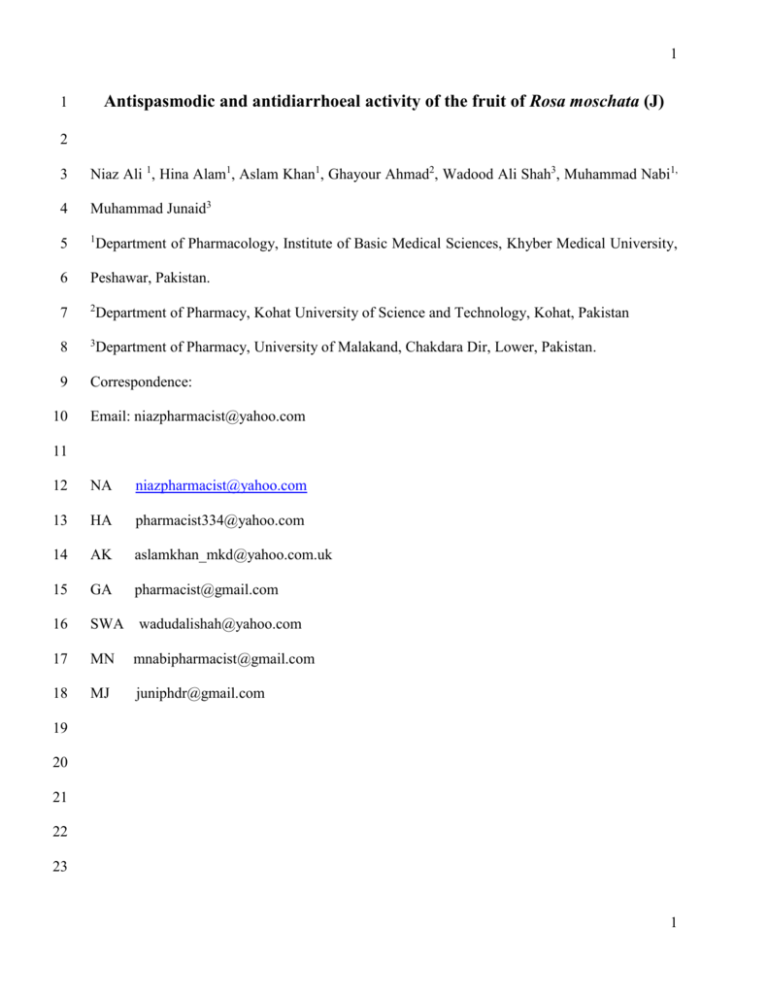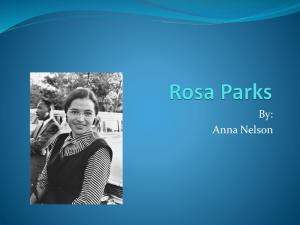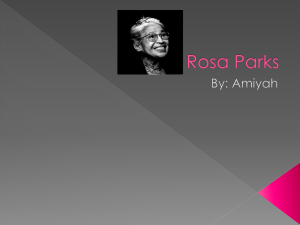Acute toxicity was performed as reported
advertisement

1 Antispasmodic and antidiarrhoeal activity of the fruit of Rosa moschata (J) 1 2 3 Niaz Ali 1, Hina Alam1, Aslam Khan1, Ghayour Ahmad2, Wadood Ali Shah3, Muhammad Nabi1, 4 Muhammad Junaid3 5 1 6 Peshawar, Pakistan. 7 2 Department of Pharmacy, Kohat University of Science and Technology, Kohat, Pakistan 8 3 Department of Pharmacy, University of Malakand, Chakdara Dir, Lower, Pakistan. 9 Correspondence: 10 Department of Pharmacology, Institute of Basic Medical Sciences, Khyber Medical University, Email: niazpharmacist@yahoo.com 11 12 NA niazpharmacist@yahoo.com 13 HA pharmacist334@yahoo.com 14 AK aslamkhan_mkd@yahoo.com.uk 15 GA pharmacist@gmail.com 16 SWA wadudalishah@yahoo.com 17 MN mnabipharmacist@gmail.com 18 MJ juniphdr@gmail.com 19 20 21 22 23 1 2 24 ABSTRACT 25 26 Background: The fruit of Rosa moschata has traditionally been used for the treatment of 27 abdominal spasm and diarrhoea. Therefore, the aim of this study was to investigate 28 mechanism(s) responsible for its medicinal use in gut spasm and diarrhea. 29 Methods: Hydro-methanolic extract of Rosa moschata (Rm.Cr) was studied in isolated rabbit’s 30 jejunal preparations for possible antispasmodic activity. Based upon in vitro relaxant activity in 31 isolated gut preparations, in vivo antidiarrheal activity was carried out in mice to confirm its 32 antidiarrheal effect. Acute toxicity study was performed to determine safe dose range before in 33 vivo experiments. 34 Results 35 In isolated rabbits’ jejunal preparations, Rm.Cr inhibited the spontaneous and high K+-induced 36 contractions with respective EC50 values of 0.66 (0.44-0.97; n=5) and 2.28 mg/mL (1.43-3.62; 37 n=5), like that of verapamil. This suggests the presence of calcium channel blocking (CCB) 38 activity, as a possible mode of action. The Ca++ channel blocking activity was further confirmed 39 when pre-treatment of isolated jejunums with Rm.Cr (1-5 mg/mL) caused a rightward shift in the 40 Ca++ concentration-response curves (CRCs), similar to verapamil. Rm.Cr was safe up to 2000 41 mg/kg for in vivo acute toxicity. Rm.Cr provided 55% and 80% protection from diarrhoea in 42 respective doses of 100 mg/kg and 1000 mg/kg. These data indicates that the crude extract of 43 Rosa moschata possesses Ca++ antagonist-like constituent(s), which explains its inhibitory effect 44 on gut motility; a mechanism that underlies its antidiarrheal and antispasmodic activities. 45 Conclusion: The study shows that the crude extract of fruits of Rosa moschata possesses 46 antispasmodic effects mediated possibly through voltage gated Ca++ channel blockade, which 2 3 47 provides sound pharmacological base to its medicinal use in gut spasms and diarrhoea, though 48 additional mechanism(s) cannot be ruled out. 49 KEY WORDS: 50 Abbreviations: Rm.Cr: crude methanolic extract of Rosa moschata; CCB: calcium channel 51 blocking; CRCs: concentration-response curves 52 BACKGROUND 53 Plants have been used from a long while for the treatment of various diseases and 80,000 species 54 out of 250,000 of higher plants are used medicinally [1]. The use of natural products are 55 considered safe as compared to synthetic products, so the beliefs on using the synthetic products 56 is decreasing compared to natural products [2]. Herbal medicines show potential uses in future 57 because most of the plants, their activities and pharmacological activities have not being 58 explored completely [3]. 59 Rosa moschata belongs to a family called rosaceae [4]. There are more than 120 species of rose. 60 Seven species of rosaceae are found in Malakand region [4, 5]. The local names are “zangley 61 gulap”, “kurach”, ”Qorach” in Pakistan and “kuja” ,“Kojai” ,“kunia” in India [4, 6-10]. It is 62 small perennial climbing shrub and its flowers, leaves, fruits or whole plant is used medicinally. 63 It is traditionally used in eyes’ disorders, diarrhoea, wounds healing, stomach disorders, delivery 64 cases and in bilious affections [6, 8, 11-13]. It has also vermicidal properties [9]. Folklorically, 65 the Rosa moschata is also used as laxative agent [14]. However, as laxative agent, no specific 66 “part used” have been refernced thereby providing a space for resaerchers to explore. Its 67 antioxidant property has been explored on scientific background [15]. 68 The fatty acid composition of Rosa moschata has been determined by gas chromatography and 69 then confirmed by the gas chromatography mass spectroscopy (GC-MS) which contains stearic Rosa moschata; antidiarrhoeal; antispasmodic; Ca++ antagonist; verapamil 3 4 70 acid, palmitic acid, oleic acid, margaric acid, linoleic acid and linolenic acid. The other isolated 71 compounds of Rosa moschata are Vitamin A, C, E, flavonoids and essential oil [5, 16, 17]. Other 72 species of the genius rosa like Rosa damascena have been reported to have spasmogenic (low 73 concentration) and spasmolytic activity (in higher concentration) on rats’ ileum [18]. In addition, 74 relaxant activity of Rosa damascena on guinea pig tracheal chains has been reported [19]. 75 Due to its medicinal use in gut spasm and diarrhea, the current work focused to provide 76 pharmacological basis for the medicinal use of Rosa moschata in gut spasms. 77 MATERIALS AND METHODS 78 Plant materials and extraction of crude extract 79 Fresh fruits of Rosa moschata were collected from Malakand region and authenticated by 80 Professor Dr. Jehandar Shah, ex vice chancellor and plant taxonomist, University of Malakand, 81 Pakistan. A voucher specimen (RM-2103) has been deposited in the Department of 82 Pharmacology. 83 Plant materials, free of adulterants, were repeatedly extracted (3 times) with commercial grade 84 methanol (80%) at room temperature and the combined extract was evaporated in rotary 85 evaporator at 35-40 °C to a semisolid mass, the crude extract of Rosa moschata. The extract 86 (free of solvent) was solubilized in normal saline and distilled water for the in-vivo and in-vitro 87 experiments, respectively. 88 Drugs and standards 89 Analytical grade chemicals were used throughout these experiments. Acetylcholine was 90 purchased from BDH, Poole, England, which was used for the maintenance of tissues at 91 quiescent doses. Rest of the chemicals were of E Merck grade. Stock solutions of all the 4 5 92 chemicals were made in distilled water and the dilutions were made fresh in normal saline on the 93 days of experiments. 94 Animals 95 BALB/C mice (weighing 25-30 g, hired from NIH, Islamabad) and local breed rabbits (weighing 96 1.5-2 kg) of either sex were housed at the animal house of the Institute of Basic Medical 97 Sciences, Khyber Medical University, Peshawar, Pakistan under a controlled environment (23-25 98 °C). The animals were kept in respective cages and were fasted overnight before starting the 99 experiments. Advanced Study & Research Board and Ethical Board of Khyber Medical 100 University approved the study protocols (ASRB000152/AA/IBMS/20/03/2014). 101 Preliminary phytochemical screenings 102 Plant extracts was tested for various active principles i.e. Triterpenoids, Steroids, Glycosides, 103 Saponins, Alkaloids, Flavonoids, Tannins, and Carbohydrate using different tests such as 104 Liebermann Burchard test was used for steroids and triterpenoids, Keller Killiani and Bromine 105 water test for Glycosides, Foam test for Saponins, Hager's test for Alkaloids, Ferric chloride test, 106 Alkaline reagent test and Lead acetate solution test for Flavonoids, Gelatin test for Tannins, 107 Biuret test for proteins and Benedict's test for carbohydrates described by Bhaddray, 2012 [20]. 5 6 108 Acute toxicity 109 Acute toxicity was performed as reported previously by Ali et al. 2013 [21]. Briefly, animals 110 were divided in groups of 5 mice in each group. The test was performed in test doses of 1, 10, 111 1000 and 2000 mg/kg, given through intraperitoneal route. Another group of mice was 112 administered normal saline which served as negative control. The mice were allowed food and 113 water ad libitum during 24 hours test period. The animals were under regular observations for 114 gross behavioural changes and mortality during the said period. 115 Isolated tissue preparations 116 The isolated tissues experiments were performed in accordance with protocols established in our 117 lab [21, 22]. Rabbits were fasted for 24 hours before the experiments with free access to water. 118 Then rabbits were sacrificed by cervical dislocation, the abdomens were cut open and the jejunal 119 portions were isolated. Preparations of about 2 cm long were mounted in 15 mL tissue baths 120 containing Tyrode’s solution maintained at 37 ○C, constantly aerated with carbogen (a mixture of 121 5% carbon dioxide in oxygen). The composition of Tyrode’s, in mM, was: NaCl 136.9, KCl 2.7, 122 NaHCO3 11.9, MgCl2 1.1, Glucose 5.6, NaH2PO4 0.4, and CaCl2 1.8 (pH 7.4). Tension of about 123 1.0 g of preload was applied to tissues and subsequently kept undisturbed for 30 min for 124 stabilization. Upon stabilization of the isolated jejunal tissues, reproducible control responses of 125 acetylcholine (0.3 M) were obtained. 126 Under these experimental conditions, rabbits’ jejunums exhibited spontaneous contractions, 127 allowing testing for possible relaxant (spasmolytic) activity directly without the use of 128 spasmogen or an agonist. 129 Calcium antagonist activity 6 7 130 To assess whether the spasmolytic activity of the test substances was mediated through voltage 131 gated Ca++ channels blockade, high concentration of K+ (80 mM), as KCl, was used to 132 depolarize the preparations [21,22], which produced sustained contractions. Cumulative dosing 133 of verapamil (standard) and extract of Rm.Cr was then added to isolated tissue baths to obtain 134 concentration-dependent inhibitory responses. The relaxation of isolated jejunal tissues, pre- 135 contracted with K+ was expressed as percent of the control pre-contractions. 136 Ca++ channel blocking activity of plant extract was confirmed when the tissues were first 137 stabilized in normal Tyrode’s solution and normal Tyrode’s solution was replaced with Ca++ 138 free Tyrode’s solution containing EDTA (0.1 mM) for 30 minutes. EDTA chelates the Ca++. 139 This solution was then replaced with K+-rich and Ca++-free Tyrode's solution, having the 140 following composition: NaCl 91.04, KCl 50, NaHCO3 11.90, MgCl2 1.05, glucose 5.55, 141 NaH2PO4 0.42 and EDTA 0.1 mM. Control concentration-response curves (CRCs) of Ca++ were 142 obtained after an incubation period of 30 minutes. When the CRCs of Ca++ were found 143 superimposable (usually after two cycles), the tissues were then pretreated with Rm.Cr for 60 144 minutes to test the possible Ca++ channel blocking effect. The CRCs of Ca++ were reconstructed 145 in the presence of different concentrations of the plant extract and verapamil (standard). 146 Data recording and Interpretation 147 Isotonic Transducer (MLT 0210/A Pan Lab) were used to record the intestinal recordings, 148 connected with Power lab (Model No: 4/26 T) AD Instruments, Australia. Bridge Pod Amplifier 149 connected with the Power lab was used for amplification of the intestinal responses. 150 Lab Chart 7 supplied with the power Lab was used to record and interpret the data. 151 152 Effects on castor oil-induced diarrhea 7 8 153 Based on positive relaxant activity of Rm.Cr on gut mortality, the in-vivo antidiarrheal activity of 154 the extract was carried out following the methods as described in our previous articles with slight 155 modifications [23]. In this study, Balb C albino mice were kept on overnight fasting. Five groups 156 of the mice were made and kept in five different steel cages containing four mice in each. 157 Bottom of each cage was covered with blotting sheet. Normal saline (10 mL/kg, orally) was 158 given to first group and labeled as the negative control. Rm.Cr was administered orally by intra- 159 gastric feeding needle to the second third and fourth group in doses of 100, 300 and 1000 mg/kg 160 keeping in view the acute toxicity results. Loperamide (10 mg/kg p.o.) was given to the fifth 161 group as positive control. 10 mL/kg of castor oil (p.o.) was given to all the groups after one hour 162 post extract/test sample treatment. All the groups were then observed for the presence of 163 diarrhoeal droppings in the individual cages for 4 hours after ingestion of the castor oil. Based on 164 the number of dry and wet feces, percent protection against the castor oil-induced diarrhoea was 165 calculated for each group. 166 167 Data Analysis 168 Data are expressed as mean ± standard error of the mean (SEM) and the median effective 169 concentrations (EC50) values were given with 95% confidence intervals (CI) using Graph Pad 170 Prism. 171 RESULTS AND DISCUSSION 172 Upon preliminary phytochemical screenings, Rosa moschata tested positive for presence of 173 tannins, flavonoids, saponins, phenolics, proteins and terpenoids. It tested negative for alkaloids, 174 quinones, sterols and glycosides (Table 1). Acute toxicity results proved that the extract is safe 8 9 175 up to 2000 mg/kg. The percent survivors are expressed in figure 1. This reflects good safety 176 profile of the sample making it a possible candidate for the development of herbal products. 177 As there is no study available on the antispasmodic and antidiarrheal activity of this plant, 178 therefore, this study was undertaken to provide the pharmacological basis for its medicinal use in 179 hyperactive gut disorders and to investigate the mechanism of its spasmolytic effect. For this 180 purpose this study was carried out on gut motility in isolated spontaneously contracting rabbits’ 181 jejunums, where cumulative addition of crude extract of Rosa moschata caused concentration- 182 dependent inhibition of the spontaneous and high K+ induced contractions, with EC50 values of 183 8.21 mg/mL (6.66 – 10.12) and 3.93 (3.39 - 4.55), respectively (Fig. 2A). In similar pattern, 184 verapamil, a standard Ca++ antagonist [22], relaxed the spontaneous and high K+ induced 185 contractions, with EC50 values 0.51 mg/mL (0.43 – 0.60) and 0.16 mg/ml (0.13 – 0.21), 186 respectively (Fig. 2B). This shows smooth muscle relaxant (antispasmodic) activity may be 187 mediated through calcium antagonistic effect as high K+ (> 30 mM) is known to cause smooth 188 muscle contractions through opening of voltage-dependent L-type Ca++ channels, thus allowing 189 influx of extracellular Ca++ causing a contractile effect [24] and the substance which cause 190 inhibition of high K+-induced contraction is considered to be an inhibitor of Ca++ influx [25]. 191 Extract of the Rosa maschata relaxed the high K+-induced contractions, similar to that caused by 192 verapamil (standard Ca++ antagonist [26] indicating its CCB action. The Ca++ antagonist effect of 193 Rosa moschata was further confirmed when Rm.Cr dose dependently (1 – 5 mg/mL) shifted the 194 Ca++ concentration response curves to the right (Fig. 3A), like that caused by verapamil (Fig. 195 3B). Ca++ antagonists have been shown to be beneficial in gut disorders resulting from 196 hyperactivity such as diarrhoea and abdominal cramps [27]; hence the observed CCB effect 197 justifies the medicinal use of Rosa moschata in such conditions. This observed Calcium channel 9 10 198 blocking effect of the plant may be due to the presence of flavonoids, as evident from 199 phytochemical screening, because the constituents of this class of compounds have been reported 200 to have Calcium channel blocking activity [28, 29], however, contribution of other compound 201 may not be ruled out. This is the first functional study on the gut motility with possible mode of 202 action, carried out on the fruit of Rosa moschata. 203 Based on the relaxant effect of Rosa moschata on spontaneous and K+ induced contractions in 204 isolated jejunal preparations, an in vivo model was used to test the extract for possible inhibitory 205 effect on gut motility as for possible antidiarrhoeal activity. The crude extract provided 206 protection from diarrhea in castor oil-induced diarrhea, similar to loperamide, a standard 207 antidiarrheal agent [30]. Both extract and loperamide significantly inhibited (P < 0.05) the 208 frequency of defecation as well as wetting of feces when compared with the untreated group (i.e. 209 mice which only received castor oil but neither crude extract, nor loperamide). The percent 210 protection provided by the crude extract was 25 ±5, 55 ±5 and 80 ±13.2 at doses of 30, 100 and 211 1000 mg/kg respectively. Loperamide provided 100% protection at 10 mg/kg (Figure 4). 212 Hydrolysis of castor oil results in the formation of recinoleic acid [31], which produces changes 213 in the transport of water and electrolytes resulting in a hypersecretory response and generation of 214 a giant contraction of the intestine [32]. Thus, a potential antidiarrheal agent may exhibit its 215 antidiarrheal effect by inhibiting either contraction of smooth muscles of the gut or electrolyte 216 out flux [33]. 217 In summary, this study shows that the crude extract of Rosa moschata possesses antispasmodic 218 and antidiarrheal effects, mediated possibly through Ca++ channel blockade, which provides 219 sound pharmacological base to its medicinal use in diarrhoea and gut spasms, though additional 220 mechanism(s) cannot be ruled out. 10 11 221 Acknowledgements 222 The author thanks Professor Dr. Jehandar Shah for identifying the plant. The authors want to 223 thank the Higher Education Commission of Pakistan for providing research grant no: 20- 224 1723/R&D/10 for establishment of pharmacology laboratory at IBMS, KMU. 225 Authors’ contributions 226 NA: Data interpretation, preparation of the manuscript. HA: Performed antispasmodic activity 227 (M.Phil Scholar). AK: helped in constructing calcium chloride curves and manuscript 228 preparation. GA: Data 229 acquisition. SWAS: Data acquisition and helped in Phytochemistry determination. MN: Data 230 acquisition of antidiarrhoeal activity. MJ: helped in Phytochemistry. All the authors have read 231 and approved the final proof of the manuscript. 232 Competing interests 233 The authors declare that they have no competing interests. 234 REFERENCES 235 236 237 238 239 240 241 242 243 244 1. Fabricant DS, Farnsworth NR. The value of plants used in traditional medicine for drug discovery. Environmental Health Perspectives. 2001;109:69. 2. Joy P, Thomas J, Mathew S, Skaria BP. Medicinal plants. Tropical horticulture. 1998;2:449-632. 3. Hassan BAR. Medicinal Plants (Importance and Uses). Pharmaceutica Analytica Acta. 2012. 4. Barkatullah B, Ibrar M. Plants profile of Malakand Pass Hills, District Malakand, Pakistan. African Journal of Biotechnology. 2013;10:16521-35. 5. Sharma B, Singh B, Dhyani D, Verma PK, Karthigeyan S. Fatty acid composition of wild growing rose species. Journal of Medicinal Plants Research. 2012;6:1046-9. 11 12 245 246 6. Sharma P, Devi U. Ethnobotanical uses of Biofencing Plants in Himachal Pradesh, Northwest Himalaya. Pakistan Journal of Biological Sciences. 2013;16:1957-63. 247 7. Sher H, Elyemeni M, Sher H, Hussain K. Ethnobotanical and Economic Observations 248 of Some Plant Resources from the Northern Parts of Pakistan. Ethnobotany Research 249 & Applications. 2011;9:27-41. 250 8. Ajmal S, Mohammad S, Zahid K, Bakht Z, Habib A, Alam M. Ethnomedicinal and 251 phytoeconomic elaboration of Lilownai valley, district Shangla Pakistan. Int Res J 252 Pharm. 2012;3:164-9. 253 9. Dutt B, Sharma S, Sharma K, Gupta A, Singh H. Ethnobotanical survey of plants used 254 by Gaddi tribe of Bharmour area in Himachal Pradesh. Himalayan Ecology. 255 2011;19:22. 256 257 10. Kumar A, Mitra M, Singh G, Rawat G. An inventory of the flora of binog wildlife sanctuary, mussoorie, garhwal Himalaya. 258 11. Akhtar N, Rashid A, Murad W, Bergmeier E. Diversity and use of ethno-medicinal 259 plants in the region of Swat, North Pakistan. Journal of ethnobiology and 260 ethnomedicine. 2013;9:25. 261 12. Ali H, Sannai J, Sher H, Rashid A. Ethnobotanical profile of some plant resources in 262 Malam Jabba valley of Swat, Pakistan. Journal of Medicinal Plants Research. 263 2011;5:4676-87. 264 13. Khare CP. Indian medicinal plants: an illustrated dictionary: Springer; 2007. 265 14. Jehanzeb K, Rooman K, Rizwana Aleem Q. Ethnobotanical Study of Commonly Used 266 Weeds of District Bannu, Khyber Pakhtunkhwa (Pakistan). J Med Plant Stud. 267 2013;2:1-6. 268 269 15. Franco D, Pinelo M, Sineiro J, Núñez MJ. Processing of Rosa rubiginosa: Extraction of oil and antioxidant substances. Bioresource technology. 2007;98:3506-12. 270 16. Matthews V. New Plantsman: Royal Horticultural Society; 1994. 271 17. Honarvar M, Javidnia K, Khosh-Khui M. Essential oil composition of fresh and dried 272 flowers of Rosa moschata from Iran. Chemistry of Natural Compounds. 2011;47:826-8. 12 13 273 18. Sadraei H, Asghari G, Emami S: Inhibitory effect of Rosa damascena Mill flower 274 essential oil, geraniol and citronellol on rat ileum contraction. Research in 275 pharmaceutical sciences 2013, 8(1):17-23. 276 19. Boskabady MH, Kiani S, Rakhshandah H: Relaxant effects of Rosa damascena on 277 guinea pig tracheal chains and 278 ethnopharmacology 2006, 106(3):377-382 its possible mechanism(s). Journal of 279 20. Bhandary SK, Kumari N, Bhat VS, Sharmila K, Bekal MP. Preliminary phytochemical 280 screening of various extracts of Punica granatum peel, whole fruit and seeds. J 281 Health Sci. 2012;2:35-8. 282 21. Ali N, Shah I, Shah SW, Ahmed G, Shoaib M, Junaid M, et al. Antioxidant and 283 relaxant activity of fractions of crude methanol extract and essential oil of Artemisia 284 macrocephala jacquem. BMC complementary and alternative medicine. 2013;13:96. 285 22. Ali N, Ahmed G, Shah SWA, Shah I, Ghias M, Khan I. Acute toxicity, brine shrimp 286 cytotoxicity and relaxant activity of fruits of Callistemon citrinus curtis. BMC 287 complementary and alternative medicine. 2011;11:99. 288 23. Gilani AH, Rehman NU, Mehmood MH, Alkharfy KM: Species differences in the 289 antidiarrheal and antispasmodic activities of Lepidium sativum and insight into 290 underlying mechanisms. Phytotherapy research : PTR 2013, 27(7):1086-1094 291 292 293 294 295 296 24. Farre AJ, Colombo M, Fort M, Gutierrez B. Differential effects of various Ca2+ antagonists. Gen Pharmacol. 1991;22:177-81. 25. Bolton TB. Mechanisms of action of transmitters and other substances on smooth muscle. Physiol Rev. 1979;59:606-718. 26. Godfraind T, Miller R, Wibo M. Calcium antagonism and calcium entry blockade. Pharmacol Rev. 1986;38:321-416. 297 27. Fleckenstein A. Specific pharmacology of calcium in myocardium, cardiac 298 pacemakers, and vascular smooth muscle. Annual review of pharmacology and 299 toxicology. 1977;17:149-66. 13 14 300 28. Pasricha PJ. Treatment of disorders of bowel motility and water Flux. In: Brunton LL, 301 Lazo JS, Parker KL, editors. The pharmacological basis of therapeutics. New York: 302 McGraw-Hill New York; 2006. p. 983-1008. 303 29. Carlo G, Izzo A, Maiolino P, Mascolo N, Viola P, Diurno M, et al. Inhibition of 304 Intestinal Motility and Secretion by Flavonoids in Mice and Rats: Structure‐activity 305 Relationships. Journal of pharmacy and pharmacology. 1993;45:1054-9. 306 30. Revuelta MP, Cantabrana B, Hidalgo A. Depolarization-dependent effect of flavonoids 307 in rat uterine smooth muscle contraction elicited by CaCl2. Gen Pharmacol. 308 1997;29:847-57. 309 310 311 312 313 314 31. Reynolds IJ, Gould RJ, Snyder SH. Loperamide: blockade of calcium channels as a mechanism for antidiarrheal effects. J Pharmacol Exp Ther. 1984;231:628-32. 32. Iwao I, Terada Y. On the mechanism of diarrhea due to castor oil. Japanese journal of pharmacology. 1962;12:137-45. 33. Croci T, Landi M, Emonds‐Alt X, Fur G, Maffrand JP, Manara L. Role of tachykinins in castor oil diarrhoea in rats. British journal of pharmacology. 1997;121:375-80. 315 316 317 318 319 320 321 322 323 324 325 326 327 328 329 330 331 332 333 14 15 334 335 336 337 338 339 340 341 342 343 Table 1: Phytochemical screenings of Rosa moschata. s. No 1. 2. 3. 4. 5. 6. 7. 8. 9. 10. 11. Phytochemicals Alkaloids Flavonoids Tannins Saponins Carbohydrate Quinones Sterols Phenolics Proteins Terpenoids Glycosides Remarks + + + + + + + - 344 345 346 Legends for Figures 347 Figure 1. Effect of acute treatment of Rosa moschata extract on % survivors of mice. 348 Figure 2. Concentration-response curves of; (A) the crude extract of Rosa moschata (Rm.Cr), 349 and (B) verapamil on spontaneous and high K+ (80 mM)-induced contractions. Values shown are 350 mean + SEM (n=5). 351 352 353 Figure 3. Effect of different concentrations of Rm.Cr (A, n=5) and verapamil (B, n=7) on Ca++ concentration-response curves in isolated rabbits’ jejunal preparations Figure 4: Effects of the crude extract of the leaves of Rosa moschata and loperamide on castor 354 oil-induced diarrhea in mice (mean ± SD; n =3). 15






